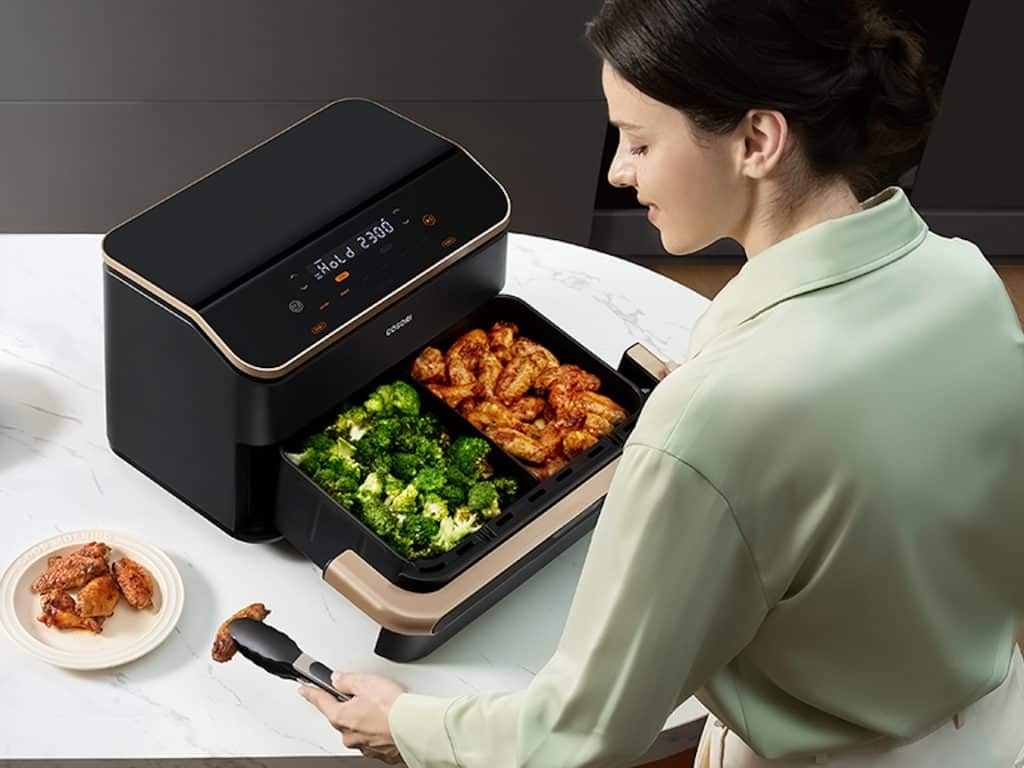
One of the sacrosanct pillars of Spanish gastronomy is frying. With the olive oil very hot, but without reaching the smoking point. Our popular recipe book cannot be conceived without frying some Padrón peppers, some ham croquettes, some wings or some cod fritters. The air fryer allows you to replicate those finishes in less time and hardly using oil. And despite being a recently introduced appliance on the market, there are already quite a few studies that analyze the nutritional value of foods in the air fryer, as well as other differences between the air fryer and the oil fryer.
How does an air fryer vs a traditional fryer work?
The traditional fryer or oil fryer consists of a bucket filled with oilIt is heated to a temperature between 170-180°C and the food is immersed for a variable amount of time until it becomes crispy. Essentially, it’s the same process as pan-frying, but without the risk of splattering.
In the air fryer there is no bucket with oil, but rather a technology of rapid air circulation at high temperatures similar to those of traditional frying. This allows you to cook with minimal or no oil.
Next, we are going to analyze the differences in oil consumption, energy expenditure and the possible impact on nutrients.
Comparison of oil consumption
The main claim of the air fryer vs traditional fryer is that it is significantly reduces the amount of oil needed for cooking by between 25% and 90%. The figures vary depending on the food, the frying temperature (if it is low, the food absorbs more fat) and the study being taken into consideration.
| Oil reduction air fryer vs traditional fryer | |
| Vegetables (especially French fries) | 34%-90% |
| Fish | 50%-74% |
| Meats | 25%-60% |
| donuts | 60% |
A little information is enough to understand one of the advantages of the air fryer: to fry a kilogram of potatoes in a pan we need to pour between half a liter and a liter of oil so that they can be completely submerged. In the oil fryer it is usually about two liters of oil. On the other hand, in the air fryer a couple of tablespoons of oil mixed with the potatoes or a similar amount sprayed with a spray dispenser will suffice.
Calories of foods in an air fryer and one of oil.
Fried foods multiply their energy intake because they absorb part of the oil when immersed in it. With the air fryer, since there is no immersion in oil, This extra contribution of calories disappears, limiting itself only to what is voluntarily added to the food..
The manufacturer Cosori He emphasizes that, according to the airfryer model, some foods with a high fat content, such as some meats, can be cooked even without adding oil, something impossible to achieve in conventional frying.
Even using the air fryer with some oil, the amount added is so small that those extra calories will be up to 85% less than with an oil fryer.
To make a comparison, the caloric result would be similar to that of preparing food in the oven, on the grill or in a grilled pan.

energy consumption
Preparing food consumes energy and generates greenhouse gases. That is, it affects environmental sustainability. The comparison between the air fryer vs oil also leans towards the former. In other words, The air fryer saves on the electricity bill without giving up the flavor and crispy texture of the food.
baking vs air fryer
One of the alternatives to frying to save oil and make food healthier is baking. This cooking technique is among the forms of healthy cooking that dietitians-nutritionists recommend. However, between preheating and baking, the oven has to be on for a long time. That triggers the energy expenditure and with it, our electricity bill. As a consequence, the carbon footprint of each dish also increases.
Let’s put it into figures with data from a study carried out by Cosori:
| Oven (minutes) | air fryer | Time saving | |
| chicken wings | 40 | 17 | 60% |
| Chips | 35 | 15 | 57% |
| Meats | 12 | 6 | 50% |
The final impact on the energy bill will depend on the cost at the time of cooking. Likewise, the carbon footprint of the energy will vary depending on its origin, that is, whether it comes from renewable or non-renewable energy.
Acrylamides with the air fryer.
Frying is an art. That golden, crunchy crust that forms on foods is the result of the Maillard reaction, a chemical process that modifies sugars and amino acids by applying high temperatures (between 120 °C and 180 °C). Below that temperature, instead of crisping up due to the Maillard reaction, foods will cook and absorb more fat. But if we exceed the temperature, harmful compounds can form, even potentially carcinogenic, such as acrylamide, benzopyrenes or polycyclic aromatic hydrocarbons (PAH). Visually they are distinguished when blackened areas and a burning smell appear.
The air fryer is no exception. These compounds can be formed, however, studies reveal that, By spending less time exposed to high temperatures, fewer harmful compounds are formed than in immersion frying. It has also been proven that by adding some natural additives, such as lemon juice or vinegar, fewer acrylamides and less PAHs are produced.

cleaning
In this section, the advantage of the airfryer is unquestionable. After each use, the basket Conveniently cleans in the sink or dishwasher. The use of paper trays also significantly reduces the grease or food remains that may remain in the basket.
Comparison of organoleptic qualities
The latest generation air fryers allow finishes that are very close to those of a vacuum fryingbaked or grilled.
Most studies acknowledge that oil-immersion fries are better in terms of color, flavor and general acceptance, but they also give a fairly positive rating to air fryer fries. In this case, the perception that they are a healthier option, with less fat, fewer calories and less acrylamide, weighs above all.
Pros and cons of the air fryer: how it affects nutrients
Cooking with heat makes food better digestible and safer. But it also affects nutrients. Generally, some of the heat-sensitive nutrients are lost, such as water-soluble vitamins (C and group B, for example). The presence of some antioxidants, whose role is of utmost importance in protecting against oxidative stress and inflammation, is also reduced.
The temperature, the time the food is exposed to heat and the cooking method determine whether more or less micronutrients are lost. The air fryer, by using more moderate temperatures and shorter cooking times, reduces nutrient loss.
Now, studies reveal that by using such a small amount of oil, the beneficial effects of some of its antioxidants are lost. Of course, this is only true with some oils, such as olive or sunflower, rich in antioxidants such as vitamin E or polyphenols. Also remember that the presence of oxygen during air cooking could accelerate the oxidation of some nutrients.
So which air fryer is healthier?
In comparison with the air fryer, conventional frying comes out, in general terms, worse valued. The air fryer is perceived as a means to achieve a healthier diet, with less loss of vitamins and antioxidants, and with less fat than traditional frying. This circumstance contributes to taking care of health and controlling weight without having to give up the crunchy texture of food.
By cooking in less time, it also gives rise to innovation or incorporating other less common foods, such as certain vegetables. In this way, it encourages greater variety in the diet.







